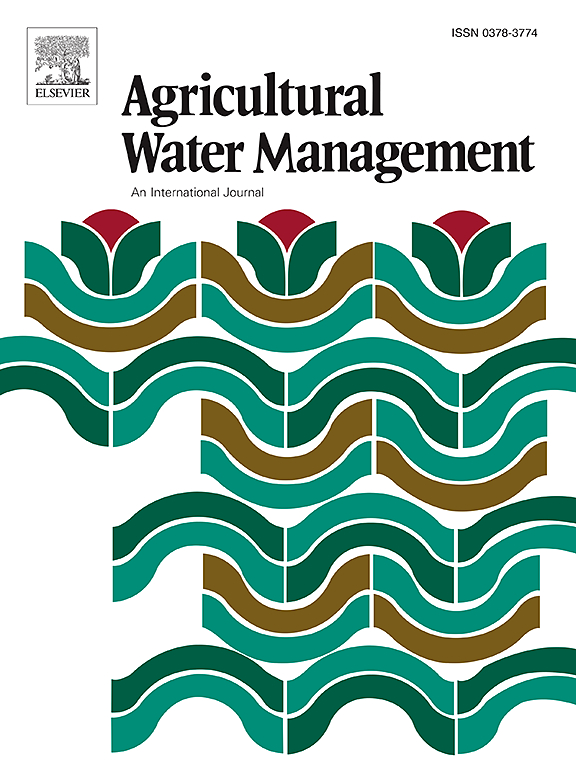利用 COMSOL-3D 模型模拟喷灌系统的土壤含水量均匀性系数
IF 5.9
1区 农林科学
Q1 AGRONOMY
引用次数: 0
摘要
配水均匀性对于评估喷灌喷头的水力性能和设计喷灌系统非常重要。然而,目前的研究很少考虑喷灌水在土壤中的再分布能力,仅根据地面均匀系数(CUg)来判断喷灌系统是否合格,这导致喷灌工程的实际灌溉效果被严重低估。因此,本研究建立并验证了 COMSOL-3D 模型,以模拟喷灌过程中土壤水的运动。此外,还探讨了土壤水力参数和灌溉参数对土壤含水量均匀性系数(CUs)的影响。结果表明:1)在两组验证实验中,垂直湿润前沿(VWF)和土壤含水量(SMC)的纳什-萨特克利夫效率系数(NSE)分别为 0.965 和 0.862 以及 0.867 和 0.900。2)由于土壤饱和导水率的差异,灌溉结束后,三种质地土壤的 VWF 垂直方向迁移率不同,其中壤土的迁移率最高,其次是粘壤土和淤泥质粘土。然而,随着输水时间的增加,它们的 CU 值也随之增加,这表明随着喷灌水在土壤中自上而下的传输和扩散,喷灌湿润区内的水分分布越来越均匀。3) 三维分析表明,CU 受土壤初始含水量、灌溉时间和输水时间的影响很大。4) 在实例 4 中,当 CUg 从 81.9% 降至 60% 时,CUs 在灌溉 48 h 后仅从 83.2% 降至 81.4%,表明喷灌水具有良好的再分配能力。该研究为合理降低喷灌工程的 CUs,实现工程投资和种植效益最大化提供了参考。本文章由计算机程序翻译,如有差异,请以英文原文为准。
Simulating coefficient of soil moisture content uniformity of sprinkler irrigation systems using a COMSOL-3D model
Water distribution uniformity is important for assessing the hydraulic performance of sprinkler nozzles and designing sprinkler irrigation systems. However, current studies rarely consider the redistribution abilities of sprinkler water in the soil and judge whether a sprinkler system is qualified based only on the coefficient of uniformity on the ground (CUg), which leads to a serious underestimation of the actual irrigation effect of sprinkler irrigation projects. Hence, this study establishes and validates a COMSOL-3D model to simulate the movement of soil water during sprinkler irrigation. Moreover, the effects of the soil hydraulic and irrigation parameters on the coefficient of soil moisture content uniformity (CUs) were explored. The results showed that 1) the Nash-Sutcliffe efficiency coefficient (NSE) of the vertical wetting front (VWF) and soil moisture content (SMC) in the two sets of validation experiments was 0.965 and 0.862 and 0.867 and 0.900, respectively. 2) Owing to the differences in soil saturated hydraulic conductivity, after the end of irrigation, the VWF transport rates in vertical direction differed among the three textured soils, with loam exhibiting the highest rate, followed clay loam and silty clay. However, their CUs increased with increasing water transport time, indicating that the water distribution within the sprinkler-wetted zone became increasingly homogeneous as the sprinkler irrigation water was transported and diffused from the top to bottom in the soil. 3) Dimensional analyses showed that CUs were strongly influenced by the initial soil moisture content, irrigation time, and water transport time. 4) In Case 4, when CUg was reduced from 81.9 % to 60 %, CUs only decreased from 83.2 % to 81.4 % after 48 h of irrigation, indicating that the sprinkler irrigation water had good redistributive ability. This study provides a reference for rationally reducing the CUs of sprinkler irrigation projects and maximising project investments and planting interest.
求助全文
通过发布文献求助,成功后即可免费获取论文全文。
去求助
来源期刊

Agricultural Water Management
农林科学-农艺学
CiteScore
12.10
自引率
14.90%
发文量
648
审稿时长
4.9 months
期刊介绍:
Agricultural Water Management publishes papers of international significance relating to the science, economics, and policy of agricultural water management. In all cases, manuscripts must address implications and provide insight regarding agricultural water management.
 求助内容:
求助内容: 应助结果提醒方式:
应助结果提醒方式:


